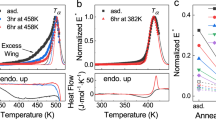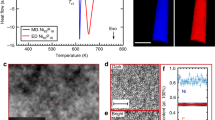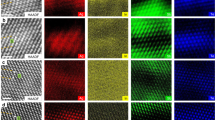Abstract
An amorphous-to-crystal transition in phase-change materials like Ge–Sb–Te is widely used for data storage. The basic principle is to take advantage of the property contrast between the crystalline and amorphous states to encode information; amorphization is believed to be caused by melting the materials with an intense laser or electrical pulse and subsequently quenching the melt. Here, we demonstrate that distortions in the crystalline phase may trigger a collapse of long-range order, generating the amorphous phase without going through the liquid state. We further show that the principal change in optical properties occurs during the distortion of the still crystalline structure, upsetting yet another commonly held belief that attributes the change in properties to the loss of long-range order. Furthermore, our results suggest a way to lower energy consumption by condensing phase change inducing energy into shorter pulses or through the use of coherent phonon excitation.
This is a preview of subscription content, access via your institution
Access options
Subscribe to this journal
Receive 12 print issues and online access
$259.00 per year
only $21.58 per issue
Buy this article
- Purchase on Springer Link
- Instant access to full article PDF
Prices may be subject to local taxes which are calculated during checkout



Similar content being viewed by others
References
Wuttig, M. & Yamada, N. Phase-change materials for rewriteable data storage. Nature Mater. 6, 824–832 (2007).
Raoux, S., Wełnic, W. & Ielmini, D. Phase change materials and their application to nonvolatile memories. Chem. Rev. 110, 240–267 (2010).
Ohta, T. & Ovshinsky, S. R. Phase-change optical data storage media, in Photo-Induced Metastability in Amorphous Semiconductors, 310–326 (Wiley-VCH, 2003).
Lacaita, A. Phase change memories: state-of-the-art, challenges and perspectives. Sol. State Electron. 50, 24–31 (2006).
Lencer, D., Salinga, M., Grabowski, B., Hickel, T. & Wuttig, M. A map for phase-change materials. Nature Mater. 7, 972–977 (2008).
Yamada, N. & Matsunaga, T. Structure of laser-crystallised Ge2Sb2+xTe5 sputtered thin films for use in optical memory. J. Appl. Phys. 88, 7020–7028 (2000).
Kolobov, A. et al. Understanding the phase-change mechanism of rewritable optical media. Nature Mater. 3, 703–708 (2004).
Shamoto, S. et al. Large displacement of germanium atoms in crystalline Ge2Sb2Te5 . Appl. Phys. Lett. 86, 081904 (2005).
Shayduk, R. & Braun, W. Epitaxial films for Ge–Sb–Te phase change memory. J. Cryst. Growth 311, 2215–2219 (2009).
Welnic, W. et al. Unravelling the interplay of local structure and physical properties in phase-change materials. Nature Mater. 5, 56–62 (2005).
Shportko, K. et al. Resonant bonding in crystalline phase-change materials. Nature Mater. 7, 653–658 (2008).
Lucovsky, G. & White, R. Effects of resonance bonding on the properties of crystalline and amorphous semiconductors. Phys. Rev. B 8, 660–667 (1973).
Kohara, S. et al. Structural basis for the fast phase change of Ge2Sb2Te5: ring statistics analogy between the crystal and amorphous states. Appl. Phys. Lett. 89, 201910 (2006).
Caravati, S., Bernasconi, M., Kühne, T., Krack, M. & Parrinello, M. Coexistence of tetrahedral- and octahedral-like sites in amorphous phase change materials. Appl. Phys. Lett. 91, 171906 (2007).
Baker, D., Paesler, M., Lucovsky, G., Agarwal, S. & Taylor, P. Application of bond constraint theory to the switchable optical memory material Ge2Sb2Te5 . Phys. Rev. Lett. 96, 255501 (2006).
Akola, J. & Jones, R. Structural phase transitions on the nanoscale: the crucial pattern in the phase-change materials Ge2Sb2Te5 and GeTe. Phys. Rev. B 76, 235201 (2007).
Jovari, P. et al. Local order in amorphous Ge2Sb2Te5 and GeSb2Te4 . Phys. Rev. B 77, 035202 (2008).
Hegedüs, J. & Elliott, S. Microscopic origin of the fast crystallization ability of Ge–Sb–Te phase-change memory materials. Nature Mater. 7, 399–405 (2008).
Gaspard, J.-P., Pellegatti, A., Marinelli, F. & Bichara, C. Peierls instability in covalent structures I. electronic structure, cohesion and the Z = 8-N rule. Phil. Mag. B 77, 727–744 (1998).
deNeufville, J. Chemical aspects of glass formation in telluride systems. J. Non-Crystal. Solids 8, 85–105 (1972).
Rahman, S., Venkata Ramana, M. & Sivarama Sastry, G. Calorimetric measurements on Ge–Bi–Se–Te glasses. J. Mater. Sci. Lett. 10, 792–794 (1991).
Luo, Y. Comprehensive Handbook of Chemical Bond Energies (CRC, 2007).
Lee, B.-S. et al. Investigation of the optical and electronic properties of Ge2Sb2Te5 phase change material in its amorphous, cubic, and hexagonal phases. J. Appl. Phys. 97, 093509 (2005).
Kato, T. & Tanaka, K. Electronic properties of amorphous and crystalline Ge2Sb2Te5 films. Jpn J. Appl. Phys. 44, 7340–7344 (2005).
Mott, N. F. & Davis, E. A. Electronic Processes in Non-Crystalline Materials. 2nd edn (Clarendon Press Oxford, 1979).
Itoh, N. & Stoneham, A. M. Materials Modification by Electronic Excitation (Cambridge Univ. Press, 2001).
Glazov, V., Chizhevskaya, S. & Glagoleva, N. Liquid Semiconductors (Plenum Press, 1969).
Santoh, H., Hongo, Y., Tajima, K., Konishi, M. & Saiki, T. Sub-picosecond non-melting structure change in a GeSbTe film induced by femtosecond pulse excitation, in Proceedings of the 2009 EPCOS Meeting, Aachen Germany (2009).
Makino, K., Tominaga, J. & Hase, M. Ultrafast optical manipulation of atomic arrangements in chalcogenide alloy memory materials. Opt. Express 19, 1260–1270 (2011).
Poborchii, V. V., Kolobov, A. V. & Tanaka, K. Photomelting of selenium at low temperature. Appl. Phys. Lett. 74, 215–217 (1999).
Roy, A., Kolobov, A. & Tanaka, K. Laser-induced suppression of photocrystallization rate in amorphous selenium films. J. Appl. Phys. 83, 4951–4956 (1998).
Elliott, S. & Kolobov, A. Athermal light-induced vitrification of As50Se50 films. J. Non-Crystal. Solids 128, 216–220 (1991).
Frumar, M., Firth, A. & Owen, A. Optically induced crystal-to-amorphous transition in As2S3 . J. Non-Crystal. Solids 192, 447 (1995).
Fons, P. et al. Photoassisted amorphization of the phase-change memory alloy Ge2Sb2Te5 . Phys. Rev. B 82, 041203 (2010).
Shimakawa, K., Kolobov, A. & Elliott, S. Photoinduced effects and metastability in amorphous semiconductors and insulators. Adv. Phys. 44, 475–588 (1995).
Hisakuni, H. & Tanaka, K. Optical microfabrication of chalcogenide glasses. Science 270, 974–975 (1995).
Yannopoulos, S. & Trunov, M. Photoplastic effects in chalcogenide glasses: a review. Phys. Status Solids (b) 246, 1773–1785 (2009).
Lyubin, V. & Klebanov, M. Photoinduced generation and reorientation of linear dichroism in AsSe glassy films. Phys. Rev. B 53, 11924–11926 (1996).
Krecmer, P. et al. Reversible nanocontraction and dilatation in a solid induced by polarized light. Science 277, 1799–1802 (1997).
Saliminia, A., Galstian, T. V. & Villeneuve, A. Optical field-induced mass transport in As2S3 chalcogenide glasses. Phys. Rev. Lett. 85, 4112–4115 (2000).
Trunov, M. Polarization-dependent laser-induced giant mass transport in glassy semiconductors. JETP Lett. 86, 313–316 (2007).
Shi, L. Optical memory: from 1st to 3rd generation and its future, in Phase-Change Materials: Science and Applications, 251–284 (Springer, 2009).
Huang, B. & Robertson, J. Bonding origin of optical contrast in phase-change memory materials. Phys. Rev. B 81, 081204R (2010).
Burr, G. W. et al. Phase change memory technology. J. Vac. Sci. Technol. B 28, 223–262 (2010).
Ravel, B. & Newville, M. ATHENA, ARTEMIS, HEPHAESTUS: data analysis for X-ray absorption spectroscopy using IFEFFIT. J. Synchrotron Radiat. 12, 537–541 (2005).
Clark, S. et al. First principles methods using CASTEP. Zeitschrift fürr Kristallographie 220, 567–570 (2005).
Ceperley, D. & Alder, B. Ground state of the electron gas by a stochastic method. Phys. Rev. Lett. 45, 566–569 (1980).
Perdew, J. & Zunger, A. Self-interaction correction to density-functional approximations for many-electron systems. Phys. Rev. B 23, 5048–5079 (1981).
Pfrommer, B. G., Cote, M., Louie, S. G. & Cohen, M. L. Relaxation of crystals with the quasi-Newton method. J. Comput. Phys. 131, 133–140 (1997).
Caravati, S., Bernasconi, M., Kuehne, T., Krack, M. & Parrinello, M. Unravelling the mechanism of pressure induced amorphization of phase change materials. Phys. Rev. Lett. 102, 205502 (2009).
Acknowledgements
Part of this work was supported by the New Energy and Industrial Technology Development Organization project ‘Research and Development of Nanoelectronic Device Technology’. The EXAFS measurements were performed as part of 2008B1249 proposal. M.K. acknowledges his Japan Society for the Promotion of Science Fellowship.
Author information
Authors and Affiliations
Contributions
The project was conceived by A.V.K. as a result of discussions with J.T. and P.F. EXAFS measurements were done jointly by P.F., A.V.K. and T.U. The data analysis was performed by A.V.K. and P.F. DFT modelling was carried out by A.V.K., M.K. and P.F. The manuscript was written by A.V.K.; all authors commented on the manuscript.
Corresponding author
Ethics declarations
Competing interests
The authors declare no competing financial interests.
Supplementary information
Supplementary information
Supplementary information (PDF 197 kb)
Rights and permissions
About this article
Cite this article
Kolobov, A., Krbal, M., Fons, P. et al. Distortion-triggered loss of long-range order in solids with bonding energy hierarchy. Nature Chem 3, 311–316 (2011). https://doi.org/10.1038/nchem.1007
Received:
Accepted:
Published:
Issue Date:
DOI: https://doi.org/10.1038/nchem.1007
This article is cited by
-
Accurate and efficient molecular dynamics based on machine learning and non von Neumann architecture
npj Computational Materials (2022)
-
Real-time nanomechanical property modulation as a framework for tunable NEMS
Nature Communications (2022)
-
Nested order-disorder framework containing a crystalline matrix with self-filled amorphous-like innards
Nature Communications (2022)
-
Infrared photovoltaic detector based on p-GeTe/n-Si heterojunction
Nanoscale Research Letters (2020)
-
Nonthermal phase transitions in metals
Scientific Reports (2020)



